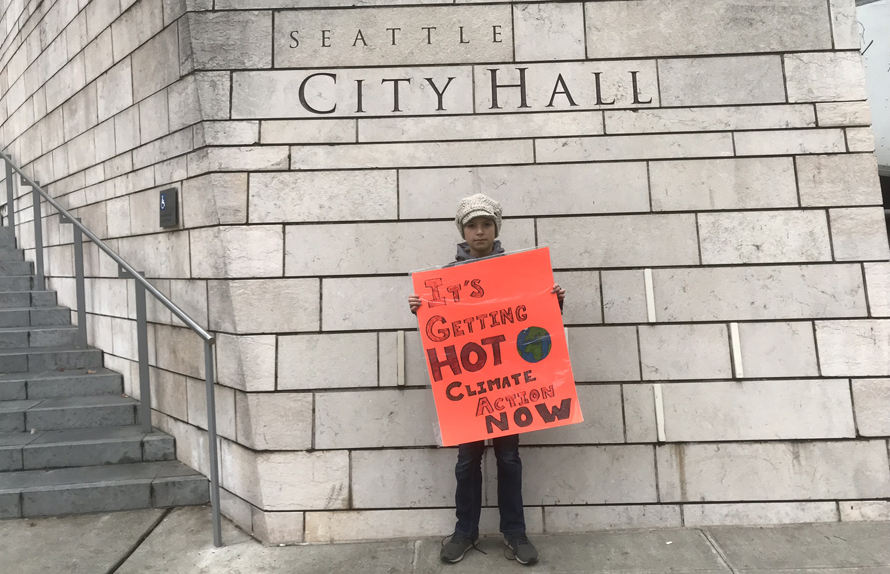
Editor's note: This article was sponsored by the Bill & Melinda Gates Foundation.
Last year, Ian Price saw videos of large youth climate strikes in England. “I saw people working really hard at something that is a problem. [Before that] I didn’t know it was that big of a problem. I wondered, are those happening in the U.S.?” he says. His mom told him that no one had started climate strikes here, yet. So, Price, like Swedish teen Greta Thunberg, the founder of the Fridays For Future movement, began to protest. For months, the 11-year-old Thornton Creek Elementary School student spent an hour on the steps of Seattle City Hall every Friday. Then, on March 15 of this year, he was joined by about 1,000 people in a climate strike organized by high school students.
After that collective strike, a revolving cast of youths (and increasingly, some adults) made it to City Hall every Friday. Price connected with the local chapters of Fridays For Future, Extinction Rebellion and Climate Action Families, a local youth-led organization linked with Plant for the Planet and Zero Hour.
If that seems like a confusing network of organizations to you, you’re not alone. Even those involved in the groups struggle to explain the relationships. “There’s a lot of collaboration between different organizations,” says Zoe Schurman, a student at Washington Middle School. But this post-Occupy generation of activists is not very interested in organizational structure, as long as someone steps forward to do the work.
Schurman says her involvement in the climate action movement was sparked by a Plant for the Planet academy she attended when she was 9.

“At the academy, I learned that I could make a difference. I saw youth doing public speaking and talking to officials. I realized I can do that, too.” Now 13, Schurman is a youth leader for Climate Action Families, working with Zero Hour. She is one of the collaborators developing a localized Green New Deal and planning Seattle events for Global Climate Strike: Week for Future, set to begin on Sept. 20.
Although Fridays For Future strikes every week, it is calling for an entire week of action this year, Sept. 20–27. These dates overlap with the first week of the 74th session of the United Nations General Assembly, when the U.N. Youth Climate Summit will provide a platform for young leaders, including Greta Thunberg, to showcase their solutions.
Around the world, youth leaders are timing actions to coincide with this event in order to raise awareness and spur change. Here in Seattle, Schurman says, “We’re going to be striking the whole week. We’re still developing outlines and plans, but there will be many mass actions, especially on the two Fridays.” Advocating for local adoption of the Green New Deal will be a focus for Seattle’s youth actions. Although rallies, marches and die-ins (protests in which participants simulate being dead) are all possibilities, Schurman is reluctant to reveal plans that have not been finalized at press time. “Seattle has been a progressive leader in the past. Why can’t we be with the Green New Deal?” asks Schurman.
After nearly a year of Friday strikes, Price realizes that nobody can do it every single week, and striking will be more complicated when he starts middle school. “I’ll probably have to study harder,” he says.
Schurman says having her parents sign her out every Friday has helped her avoid disciplinary action from her school, but she has to rely on her friends to share their notes and tell her about homework assignments. She has less time to finish assignments and has had to schedule makeup tests, all of which has probably affected her grades.
Yet she has no regrets. “People never talk about the positive impacts on my life that this has had, only the negative, and there are so many more good things. I have gained so much confidence and maturity, and have learned facts and life skills I never could have otherwise. I have learned about how social movements and our political structure works, how messed up the world is and how we can at least try to fix it. I have learned time management, responsibility and how to be professional, not to mention the huge amount of friends and fun that I have had along the way. Activism has transformed my life, but in a good way, not a bad one,” says Schurman.

“We have a bigger voice than a lot of adults,” says Price. “Don’t underestimate it.” The youths striking at City Hall have been granted meetings with city and state elected officials, including Gov. Jay Inslee. Schurman has testified at public hearings, contributing to King County’s moratorium on fossil fuel projects.
“The most common way we give up power is to think we don’t have any,” notes Schurman. Obviously, it takes a healthy dose of idealism for a bunch of kids to tackle climate change. But both Schurman and Price temper their idealism with pragmatism. “As kids, it’s not necessarily our responsibility to write policy. We just need to speak out. But the problem will only get worse the longer we wait. We should have been doing things yesterday,” says Schurman.
Acknowledging that many people can’t afford to miss school or work, Price says he has seen some kids plan actions at school — like ringing a bell every day to sound the climate alarm. “Just do what you can,” he says.
Kids and families that want to be involved in Friday For Future strikes or Global Climate Strike: Week for Future can keep track of planned events on Twitter @Fri4FutureSea.
|
Sponsored by: |
 |











